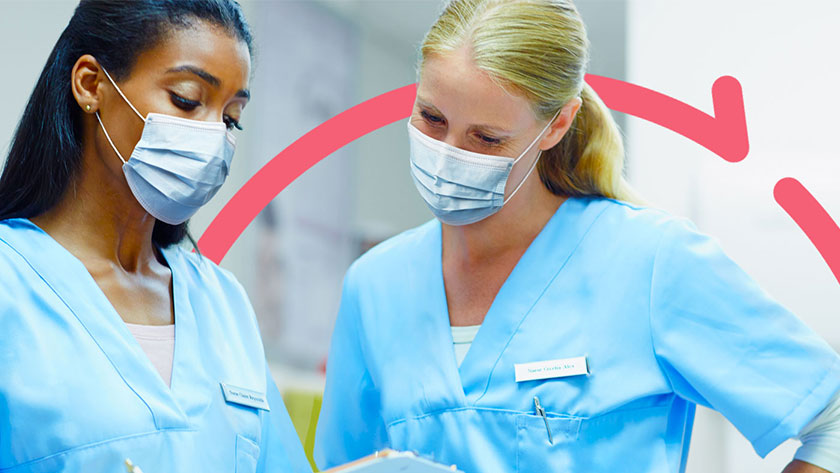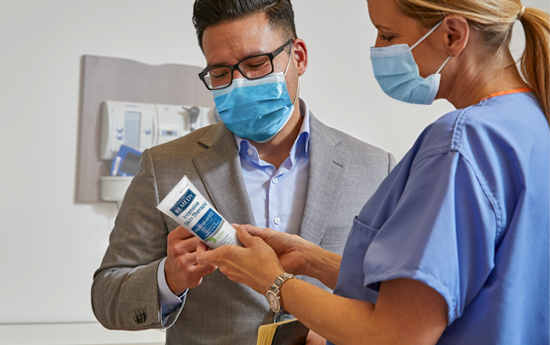How a clinical consultant helps improve patient outcomes
See how patient outcomes can improve by collaborating with other WOC nurses.

When you think about your vendor partnerships, your skin health rep might be the first person who comes to mind. Good thinking. After all, they’re your go-to resource when you need product support or product in-servicing.
Now, what happens when you also have a clinical partner available? When you can engage with someone who understands your skin health challenges first hand–and can help support your product needs—it’s a win for you and your staff and a win for your patients.
To find out more about how a clinical consultant can help your team improve patient outcomes, we spoke with Patricia Turner, BSN, RN, CWOCN, CWS, Medline Director of Clinical Resources, Skin Health.

Q: When would a facility benefit from consulting another wound care expert?
A: There’s a great benefit for facilities who come to us with a real-life patient scenario. When the facility clinician has a patient who has XYZ type of wound, and the WOC nurse or other nurse is managing it, but just not sure they’re using everything they have at their disposal, a clinical expert can help find a solution.
Q: What are some other times you might engage a clinical consultant?
A: One of the best ways to take advantage of another clinical expert is for support with a clinical initiative they’re working on, like building a Skin Champion team. Or maybe they’re trying to improve a process or protocol for preventing pressure injuries. An outside perspective can help spark new ideas.
Q: How would a facility engage with another clinician?
A: There are two great ways for a facility to do this:
The first one is through a direct conversation like we talked about above. In this case, a facility wound care nurse could reach out to their sales rep or to the clinician directly and set up a time to talk.
The second common way would be to initiate a more formal relationship, such as a clinician-led skin health assessment. This would be a more in-depth conversation that assesses the facility’s overall gaps and opportunities in their practice when it comes to skin and wound care.
Either way, the conversation should be as if we’re colleagues looking for the best possible outcomes.
Learn more about a clinician-led skin health assessment
Medline offers a detailed Skin Health Discovery Assessment, based on National Pressure Injury Advisory Panel evidence-based best practices. The on-site or virtual assessment includes observations, interviews and product utilization reviews. What do you get? Actionable steps to help you standardize skin and wound care practice and increase product use efficiencies. Request your skin health assessment now.

Q: What makes a clinician partner so valuable for improving patient care?
A: A clinician can draw from their own real-life experiences to offer a unique perspective. And it’s not only the experience of, for example, applying a sacral dressing, but the experience of assessing the patient, assessing the patient’s needs or assessing the wound and then saying, ‘OK, I have a treatment plan for this wound.’

Q: How should a WOC nurse prepare for a discussion with a consultant expert?
A: If it’s a patient-focused consultation, think about the specifics of the patient, because the clinical consultant will ask clinical questions. Questions such as, ‘What does the wound look like?’ ‘What have you done so far?’ ‘What are the workups and tests you’ve done?’ ‘What challenges are you up against?’ Really think of it as a collegial conversation.
Q: Does that discussion include product usage?
A: Part of that discussion will be helping the clinician in the facility understand the system of products we have available. Not just giving them a list of benefits and features and then leaving them to figure out what to use, but really solving their problems.
My goal is to understand what products you have available to you first. I might introduce a product that may offer a clinically superior outcome, but if it’s not possible to use that because of financial or operational decisions, then that’s OK. Then we work within the frame of what they do have.
Q: Are clinicians at the facility ever hesitant to tell you specifics about a patient?
A: In my experience, once that facility clinician connects with us, if I’m doing my job correctly, the conversation should sound like I’m sitting at the nurses’ station with them talking about their patient and the scenario that they’re up against.
The conversation should be as if we’re colleagues looking for the best possible way to implement the clinical initiative.
Q: What kind of follow-up should facilities expect from a clinical consultant?
A: It’s not just a one-and-done conversation. If what we’ve discussed and decided on progresses as well as we hope, great. If what we’ve decided on doesn’t go in the right direction, or something changes in that patient issue or clinical initiative, then we’ll go back and reassess. It should be an ongoing process.
We want to establish a relationship with that facility, so that even if significant time goes by, the facility clinician knows they can still reach out. We want to build that trust.
It should be an ongoing process. We want to establish a relationship with that facility, so that even if significant time goes by, the facility clinician knows they can still reach out. We want to build that trust.
Q: What’s the bottom line when it comes to consulting with a vendor clinician?
A: We’re nurses for a reason, and what motivates most nurses is to see positive patient outcomes. As a consultant, we’re not direct caregivers, so we see those positive patient outcomes through the clinicians we work with. There’s definitely satisfaction in hearing that the nurses on the frontline have been successful with something that I’ve collaborated with them on.
Key takeaway
You solve difficult skin and wound care challenges every day. But when you need help, it may be as close as your vendor partner, where other skin health experts can offer a new perspective. They understand your goals to prevent pressure injuries, maintain patient skin integrity and follow best practices. A clinician-led skin health Discovery Assessment is a valuable place to start. And the right educational resources can add ongoing support.
More resources for skin health support and education:
Continuing education for nurses: join your peers for evidence-based learning
Watch the video: See how a clinician partner can help you keep up with best practices
How to prevent skin breakdown: why you need a holistic approach
Download the latest edition of Healthy Skin magazine
Share these educational posters with your team
